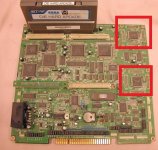based on my repair experience on the st-v boards, I think discharging the st-v caps to fix a black screen issue is a myth... if you still want to try it then don't even bother to discharge the supercap next to the battery without removing the cell battery first. otherwise your cell battery will be depleted....
anyway, the black screen may be caused by many things. most popular problem is the cracked solder joints on the legs of the cpus, mostly happens on the slave cpu which is located on the far right corner (when jamma edge facing towards you). generally people handle the pcb holding from that corner and when the pcb flexes, the solder joints crack.
I also see solder cracks on the main cpu but that was rare. good practice to re-flow both. but carefully examine your work afterwards. re-flowing may also cause solder bridges. use lots of no-clean flux while re-flowing.

Other causes for black screen I've seen;
- burned PAL
- burned work RAM
- wrong BIOS chip (ST-V PCB has two revisions. One uses 27C4100 other uses 27C4096 for BIOS. These are NOT pin compatible. Check the silkscreen under the BIOS socket to make sure)
- burned BIOS/EPROM
- One of the STV PCB revisions has a design bug that on factory they installed a cable, on the edge of the cable there is a small filter coil and that connects to the clock section. If that cable is loose or not existing (ripped off during years) then the board cannot boot.
- burned cpu (yes I've seen burned SH-2 CPU once. Sensitive to high voltage. Not that sensitive like a Naomi but still... )
Also, I've seen some writings on the net that says replacing the supercap and coin cell battery to make the board work. This is another myth. It is good practice to replace the supercap and the coin cell with fresh ones but those do not stop the board booting. Infact, I always keep my spare ST-V boards without them. The PCB works without them.
If the above usual suspects are not the cause, then you have to systematically diagnose the problem with a scope by starting with the clock and reset signals on the CPUs.
Good luck...




